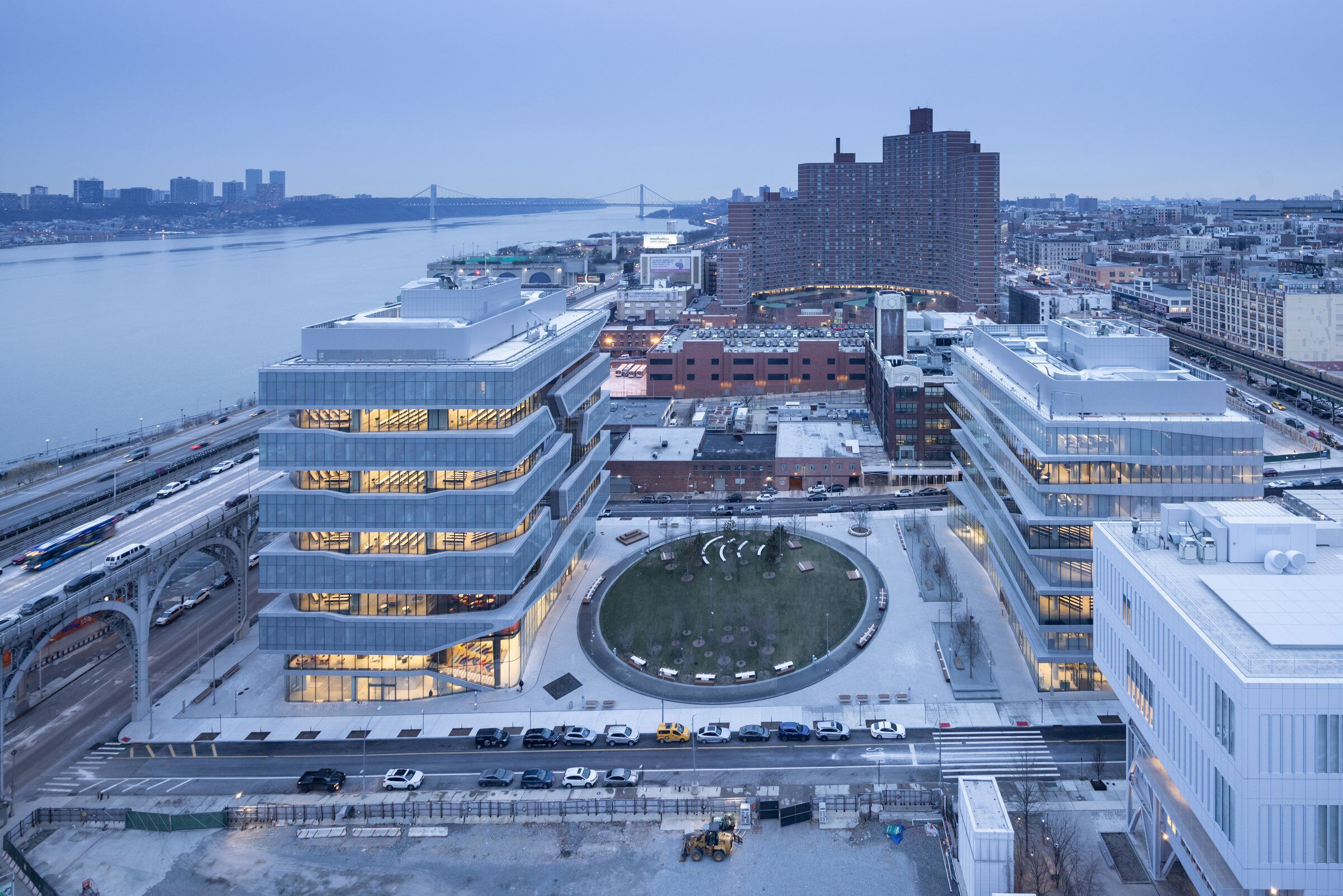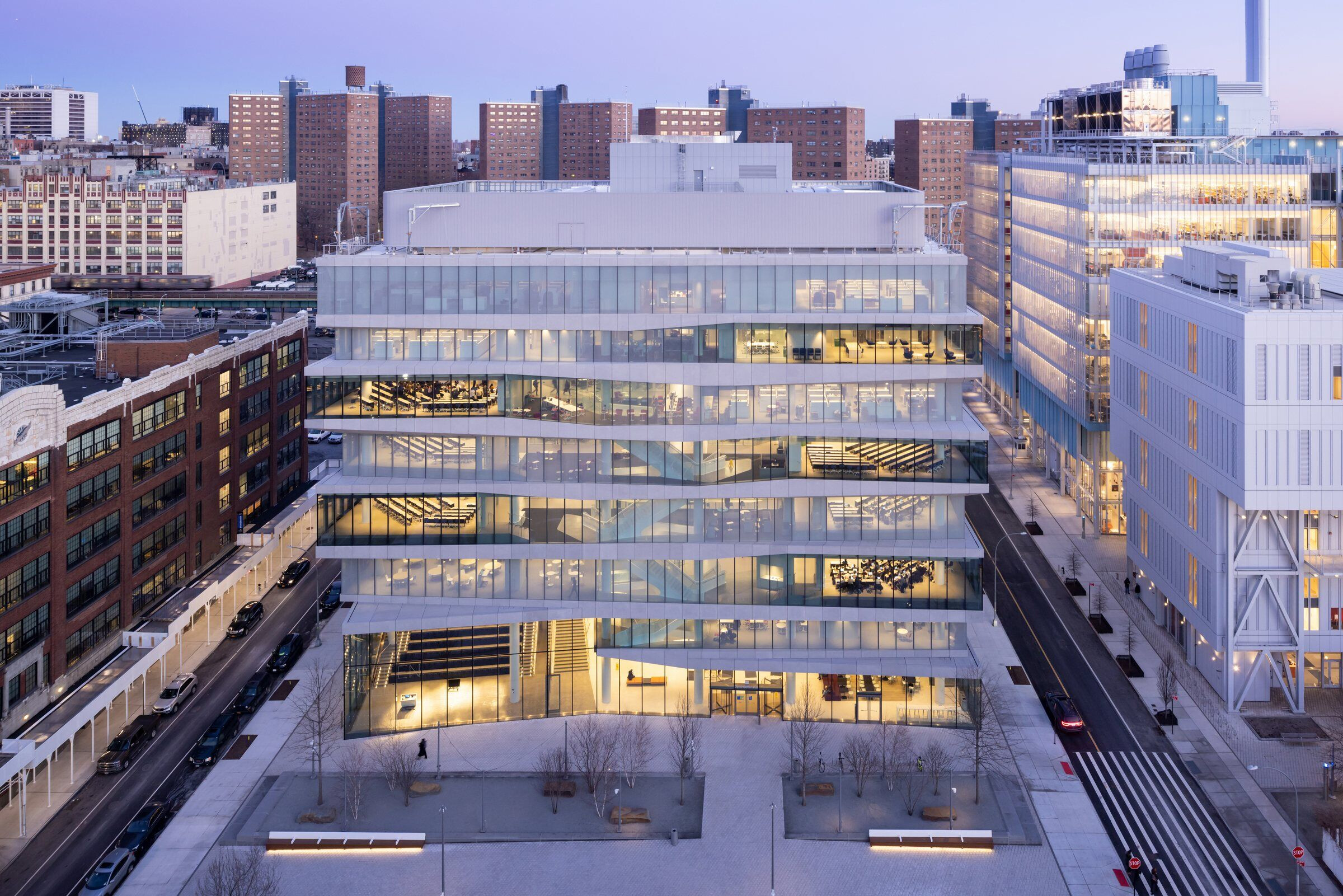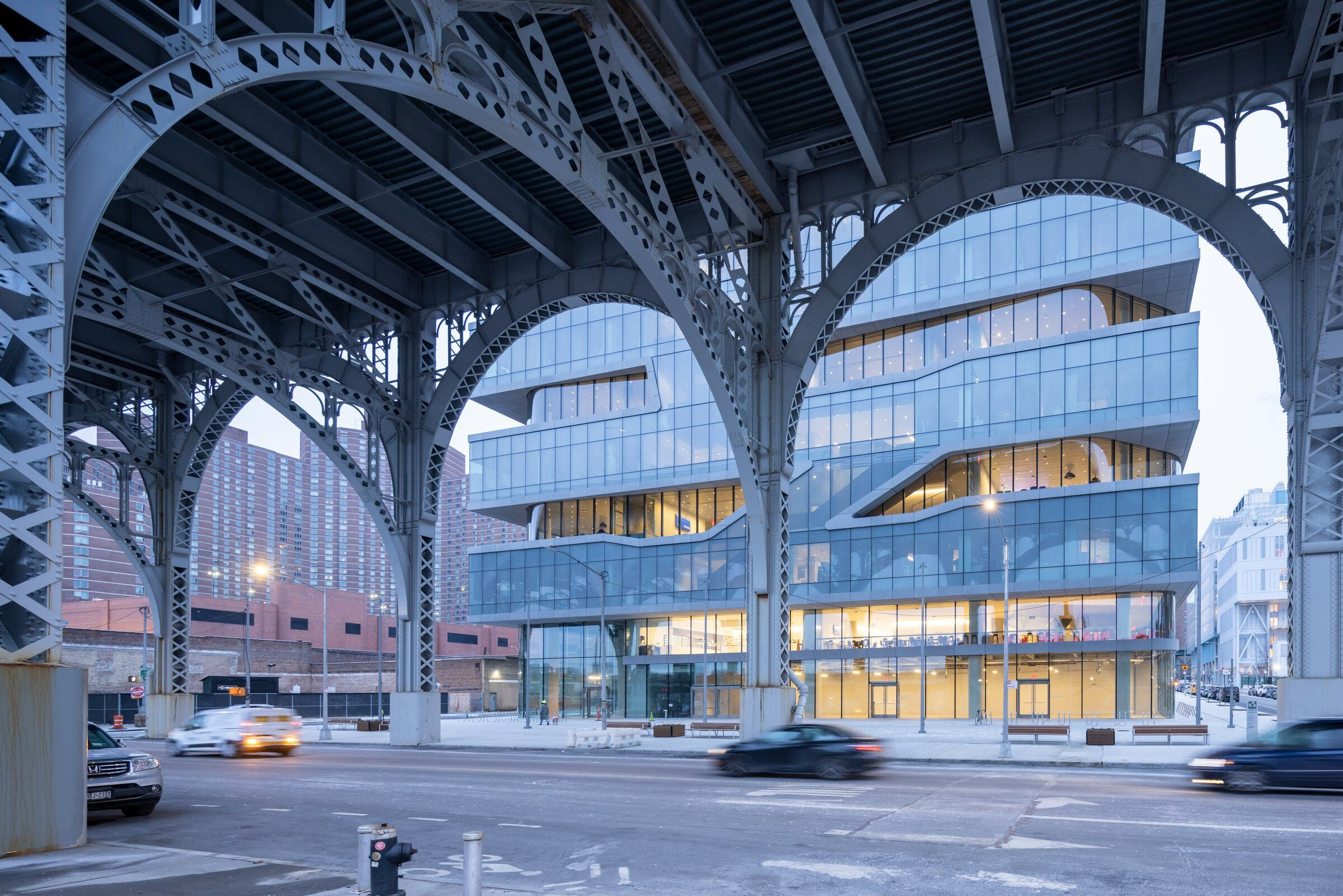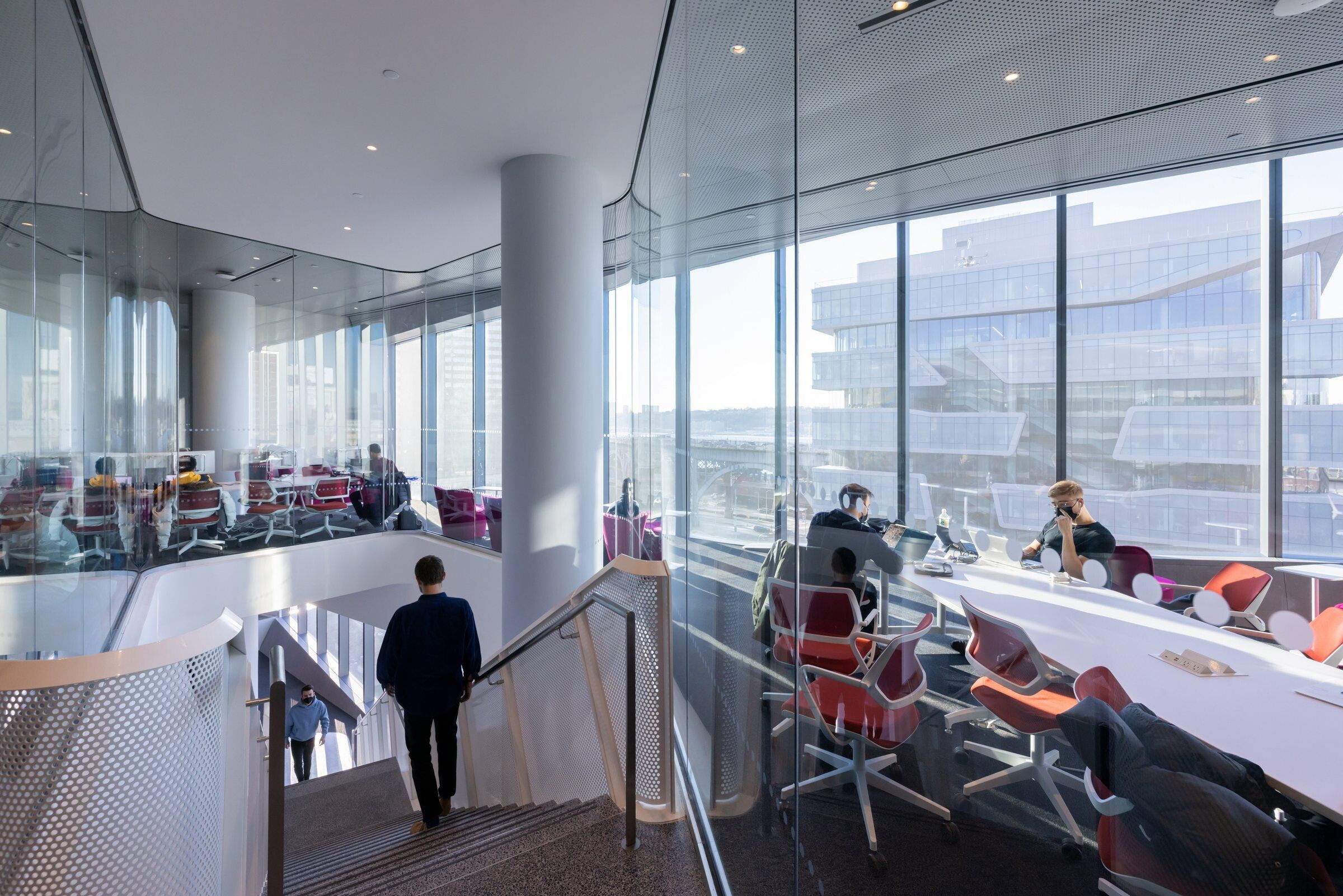Columbia Business School’s new home spans approximately 492,000 square feet across two buildings that reflect the fast-paced, high-tech, and highly social character of business in the 21st century. The two new facilities, Henry R. Kravis Hall and David Geffen Hall, double the School’s current square footage, creating multifunctional spaces that foster a sense of community—spaces where students, faculty, alumni, and practitioners can gather to exchange ideas. The design of both buildings recognizes that creativity, innovation, and communication—skills often nurtured in informal environments—are as crucial to business school pedagogy as the traditional, quantitative skills taught in a classroom.

The building organization shuffles alternating floors of faculty offices with student learning spaces in the eleven-story Kravis Hall and floors for administrative offices and learning spaces in the eight-story Geffen Hall. The shuffled program is expressed in each building’s façade with systems tailored to the populations and uses. The school’s internal spaces are organized around intersecting networks of circulation and collaborative learning environments that extend up vertically through each building, linking spaces of teaching, socializing, and studying, to create a continuous space of learning and interaction that remains vibrant 24 hours a day.

Engagement with the city and surrounding West Harlem community is a fundamental aspect of the new Columbia Business School’s design. Kravis Hall offers 360 degrees of exposure and proximity to the Hudson River. At the same time, Geffen Hall establishes a strong connection to the urban fabric of the neighborhood and the mid-block pedestrian axis of the Manhattanville master plan. Every classroom provides a view of the city and landscape. The two buildings also welcome in the community, including a new dedicated space on the second floor of Geffen Hall for the Columbia-Harlem Small Business Development Center that will build on the school’s ten-year history of supporting local entrepreneurs. A 40,000 square-foot public park and new retail spaces—including a café featuring local products—also connect Columbia Business School more closely with the surrounding neighborhood.

Location
Columbia Business School is located on Columbia’s Manhattanville campus in West Harlem, nine blocks north of Columbia’s historic Morningside Heights campus. The 17-acre campus is also home to the Lenfest Center for the Arts, the Jerome L. Greene Science Center, and The Forum, all designed by Renzo Piano Building Workshop, as well as a public park designed by James Corner Field Operations.

Major Features
The Network: As the connective tissue of the school, the Network links the primary programs of each building with a generous circulation stair that carves through each building volume, bringing daylight and air into the center of the deep floor plates. The Network links a myriad of intimate lounges, flexible seminar spaces, open-breakout, tiered seating, carrels, and informal hang-out spaces into a new type of academic space. The circulation stairs wind their way through the buildings directly adjacent to a central bank of 7 elevators that provide access to all floors. A custom wallpaper designed by Diller Scofidio + Renfro lines the elevator banks of student floors, depicting an abstract pattern of four New York City bridges - the Ed Koch Queensboro Bridge, Williamsburg Bridge, Hell Gate Bridge and the Harlem River Lift Bridge - as an ode to the city's infrastructural connections.

Ground Floors: The ground floors of each building provide a porous connection to the surrounding city streets and the broader Manhattanville campus. Each building meets the ground with a social and event space. These event spaces establish a strong visual and programmatic link across the publicly accessible central Square to create one school from two buildings. A café on the ground level of Geffen Hall and retail space located on the ground floor of Kravis Hall at 12th Avenue establish further connections between Columbia Business School and the surrounding neighborhood.

Level 1, Samberg Commons at Kravis Hall: This urban-scale living room for students, faculty, and staff features tiered, undulating seating made of oak that provides an area for multiple group study, breakout meetings, or a place to enjoy lunch. The tiered seating can accommodate 200 with a direct connection to a dining space on Level 2 with an additional capacity of 199.
Level 1, Cooperman Commons in Geffen Hall: This auditorium space can accommodate 274 and acts as a day-to-day gathering space for student orientations and faculty meetings.
Level 2, Columbia-Harlem Small Business Development Center in Geffen Hall: The space provides support resources and services to local businesses and entrepreneurs.
Level 3, Multi-Function Room in Geffen Hall: This ample enclosed space is sub-divisible into two smaller rooms for functions of different sizes. An adjacent pre-function space serves as a lobby anteroom that can also be used independently. These spaces act as a conference center with the capability to quickly transform to suit different layouts.
Level 4, Student Social Lounge in Kravis Hall: The lounge includes a screening room, game room, and casual dining spaces where students can relax and unwind.

Level 10, Dining Room in Kravis Hall: Lined with walnut wood paneling, this event space can accommodate 238 and provides a panoramic view toward the George Washington Bridge, with access to an outdoor terrace.
Innovative classrooms: Classroom floors provide natural daylight and views to New York City with the option to calibrate privacy and daylight control. 25-, 50-, 74-, and 150-seat classrooms provide diverse configuration capabilities for use in break-out, negotiation, or experiential learning scenarios. From the onset of the design in 2011, classroom technology was devised to enable remote teaching for Columbia's affiliates from around the world, which is a central part of their international program. Cameras and microphones distributed throughout all classrooms and confidence monitors for presenters enable seamless video conferencing that simulates the professor-student dynamics of in-person learning. The design also anticipated the need for increased display space, converting a majority of the non-glazed walls into projection surfaces.

Quiet Study Rooms: These spaces for serene, comfortable, individual study are outfitted with soft furniture seating approximately 100.
Group Study Rooms: Located throughout both buildings on the classroom floors, a series of similarly sized rooms can accommodate groups of six and are equipped with small conference tables, fixed monitors, marker boards, and web conferencing technology. The study rooms line the network stairs of the building cores and are clustered around 74-seat classrooms, serving a dual function as breakout rooms while classes are in session.

Technical Features
Façade: The building’s skin expresses the shuffling of students, faculty, and administrative spaces. Student floors, the Network, and ground floor spaces utilize transparent glass exteriors inset from the edge of the floor plate, while Faculty floors utilize fritted glass. Each building façade features a custom curtainwall system and is regularized based on the geometry of the exterior building form. Geffen Hall’s glass envelope is treated with a gradient from opaque to transparent, each panel having a bespoke and carefully calculated frit pattern.
Structure: Structural solutions designed in collaboration with Arup support the architectural concept of both buildings. In Kravis Hall, “skip truss” steel framing utilized on alternating faculty floors keeps open student floors with nearly column-free classrooms, as well as the building’s layered, textured form. Spiraling, sculptural circulation stairs in Kravis Hall and Geffen Hall double as vertical elements of the structure while fostering interactions between users and providing panoramic views over the campus and New York City.

Sustainability: Columbia Business School expects to achieve LEED v3 Gold certification. Knowing that students and faculty will spend long hours in the building, a particular emphasis has been placed on the quality of the indoor environment—specifically air, light, thermal comfort, and materials. The use of lowVOC materials, flushout before occupancy, increased ventilation rates, and outdoor air monitoring ensures high indoor air quality. Materials were specified with high percentages of recycled content from regional sources. Most of the wood was sourced from sustainably managed forests. The building enclosure has been developed to protect against unwanted glare, and the white frit blocks harmful solar heat gain. The cooling and heating systems utilize chilled beam technology for user comfort and reduced energy consumption and low-velocity underfloor distribution in the tiered classrooms. High-efficiency plumbing fixtures are used to reduce potable water demand.
Team:
Architects: Diller Scofidio + Renfro in collaboration with FXCollaborative
Sustainability/ LEED consultant: FXCollaborative
Owner / Client: Columbia University
Structural Engineer, Exterior Envelope and Façade Consultant: Arup
Associate Architect (Dedicated Dining, Multi-Function Room): Aaris Design Studios
Mechanical Engineer: Buro Happold
Construction Manager: Turner Construction
Lighting Design: Tillotson Design Associates
Acoustics: Cerami & Associates
Vertical Transportation: Van Deusen and Associates
Civil Engineering: Stantec Consultants
AV: Cerami & Associates, The Clarient Group, Jaffe Holden
IT: The Clarient Group, Jaros Baum & Bolles
Security: DVS Security Consulting and Engineering
Food Services: Romano Gatland
Cost Consulting: Dharam Consulting
Code: Milrose
Graphics and Wayfinding: Pentagram



























































